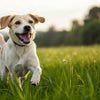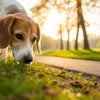Should I Feed My Dog Before or After Exercise? A Comprehensive Guide to Optimal Feeding Times
- Houndsy
Table of Contents
- Introduction
- The Impact of Exercise on Dog Nutrition
- Recommended Waiting Times: Before and After Exercise
- Signs of Digestive Distress
- Creating a Balanced Feeding Schedule
- The Role of Nutrition in Recovery
- Conclusion
- FAQ
Introduction
As devoted dog owners, we understand that feeding our furry friends is more than just filling their bowls; it's a vital part of their health and well-being. Did you know that the timing of meals in relation to exercise can impact your dog's digestive health and overall performance? According to veterinary experts, feeding your dog too soon before or after exercise can lead to serious health issues, including gastric dilatation-volvulus (GDV), commonly known as bloat.
In this post, we will explore the crucial question: Should I feed my dog before or after exercise? We aim to provide insights into the science behind meal timing, the effects of exercise on digestion, and practical guidelines to ensure your dog remains healthy and happy. By the end of this article, you will have a clearer understanding of how to optimize your dog's feeding routine in relation to their activity level, ensuring they receive the best nutrition at the right time.
We will cover various aspects, including:
- The relationship between exercise and digestion.
- Recommended waiting times before and after meals.
- Signs of digestive distress and how to prevent them.
- Creating a balanced feeding schedule tailored to your dog's unique needs.
So, let’s dive in and discover how to enhance our dog’s feeding experience, making it more enjoyable and beneficial for both of us!
The Impact of Exercise on Dog Nutrition
Exercise is essential for a dog's physical and mental health. It helps maintain a healthy weight, improves cardiovascular fitness, and provides mental stimulation. However, exercise also significantly affects how our dogs digest food. When dogs engage in physical activity, their bodies prioritize blood flow to the muscles, heart, and lungs, which can reduce blood flow to the digestive system. This shift can slow down digestion and lead to potential gastrointestinal issues if not managed properly.
The Science of Digestion During Exercise
When a dog eats, their stomach fills with food that requires energy to digest. If exercise occurs shortly after a meal, the body may struggle to balance the energy demands of both digestion and physical activity. This can result in several digestive issues, including:
- Bloating: A condition where the stomach fills with gas and can twist, leading to GDV.
- Nausea: Dogs may feel uncomfortable and may not want to engage in physical activity.
- Vomiting: Excessive exercise after a meal can trigger vomiting or an upset stomach.
To prevent these issues, it's crucial to understand the timing of meals in relation to exercise.
Recommended Waiting Times: Before and After Exercise
Before Exercise: Timing is Key
Feeding your dog immediately before exercise is generally not advisable. The recommended waiting time is at least 1 hour after a meal before engaging in vigorous physical activity. This allows the dog’s stomach to begin digesting the food and reduces the risk of discomfort during exercise.
Why Wait?
- Digestive Health: Waiting helps ensure that your dog's digestive system is not overloaded while they are active.
- Energy Availability: It ensures that the energy from their meal is available for use during exercise rather than being diverted to digestion.
After Exercise: The 30-Minute Rule
After exercising, it’s equally important to allow a recovery period before feeding your dog. We recommend waiting at least 30 to 60 minutes after exercise before offering a meal. This waiting period allows the dog's heart rate to normalize and blood flow to return to the digestive tract.
The Benefits of Waiting
- Reduced Risk of Bloat: Waiting helps minimize the risk of GDV, especially in deep-chested breeds that are more susceptible to bloat.
- Better Digestion: A calm body promotes better digestion, ensuring that your dog gets the maximum nutritional benefit from their meal.
Signs of Digestive Distress
As responsible pet owners, it’s essential to recognize the signs of digestive discomfort in our dogs. Symptoms of distress can include:
- Restlessness or discomfort: Your dog may seem anxious or unable to settle down.
- Swollen or distended abdomen: This could indicate bloating, a serious condition requiring immediate veterinary attention.
- Vomiting or attempts to vomit: If your dog is trying to vomit but not producing anything, it’s a sign of distress.
- Rapid breathing or excessive panting: This may indicate discomfort or pain.
If you observe any of these signs, it’s crucial to consult with your veterinarian immediately to address the issue.
Creating a Balanced Feeding Schedule
To optimize your dog’s feeding routine, consider their individual needs based on age, breed, size, and activity level. Here are some tips for creating a balanced feeding schedule:
1. Establish Regular Meal Times
Try to feed your dog at the same times each day. This helps regulate their digestive system and makes it easier to plan exercise around meal times. For most adult dogs, two meals a day—approximately 12 hours apart—are ideal.
2. Adjust Portions Based on Activity
Active dogs may require more food to support their energy needs. If your dog has had a particularly active day, consider slightly increasing their portion size to ensure they have enough energy to recover.
3. Monitor Weight and Health
Regularly check your dog’s weight and overall health. If you notice any changes, such as excessive weight gain or loss, consult your veterinarian to adjust their feeding plan accordingly.
4. Offer Smaller, Frequent Meals
Instead of one large meal, consider splitting your dog’s daily food into smaller, more frequent meals. This can help with digestion and keep their energy levels stable throughout the day.
The Role of Nutrition in Recovery
After exercise, it’s essential to provide your dog with the right nutrition to aid recovery. Quality food that is rich in protein and fat can help replenish energy stores and support muscle recovery.
Protein for Muscle Recovery
Active dogs require higher levels of protein to support muscle repair and growth. Look for dog foods that contain at least 26% protein and are made from high-quality, digestible sources. This will ensure that your dog receives the necessary nutrients to recover effectively after exercise.
Fat as an Energy Source
Fat is a vital energy source for dogs, especially those that are active. When selecting a dog food, choose one that has a higher fat content to provide the energy needed for sustained physical activity. Fat not only aids in energy production but also contributes to healthy skin and a shiny coat.
Conclusion
In summary, the timing of meals in relation to exercise is crucial for maintaining your dog's overall health and well-being. By waiting at least an hour before exercise and 30 to 60 minutes after exercise before feeding your dog, you can help prevent digestive issues and ensure they receive the maximum benefits from their food.
As we embrace the joys of pet ownership, it’s essential to create a feeding routine that complements our dogs’ active lifestyles. By prioritizing their nutritional needs and understanding the impact of exercise on digestion, we can foster a happier, healthier life for our furry companions.
Reflect on your current feeding routine. Are you allowing enough time between meals and exercise? If you're looking for a convenient and aesthetically pleasing way to enhance your dog's feeding experience, consider exploring our Houndsy Kibble Dispenser. It offers perfect portion control, ergonomic convenience, and a design that fits seamlessly into your home décor. To learn more, visit Houndsy Kibble Dispenser.
FAQ
Q: Can I feed my dog right after a walk?
A: It's best to wait at least 30 to 60 minutes after exercise before feeding your dog to avoid potential digestive issues.
Q: How long should I wait after feeding before exercising?
A: You should wait at least 1 hour after feeding before engaging in vigorous physical activity with your dog.
Q: What are the signs of bloat?
A: Signs of bloat include restlessness, a swollen abdomen, attempts to vomit, rapid breathing, and pale gums. If you notice these symptoms, seek veterinary care immediately.
Q: Are there specific breeds that are more susceptible to bloat?
A: Yes, deep-chested breeds like Great Danes, Doberman Pinschers, and Boxers are at a higher risk for bloat. Owners of these breeds should be particularly cautious about meal timing in relation to exercise.
Q: How can I tell if my dog is getting enough nutrition?
A: Regularly monitor your dog’s weight, energy levels, and overall health. Consult with your veterinarian if you notice any changes to adjust their diet accordingly.
By understanding the relationship between feeding and exercise, we can ensure our beloved dogs lead happy, healthy lives.












